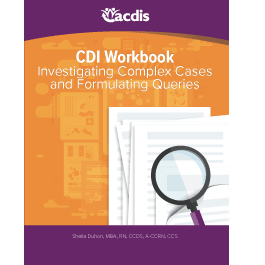Book excerpt: Physician education on anemia documentation

Cases and Formulating Queries
By Sheila Duhon, MBA, RN, CCDS, A-CCRN, CCS
It’s often a challenge for CDI specialists to obtain precise documentation of anemia in the medical record. A hospitalist once asked me why I sent him a query for anemia because since he would treat it the same way no matter what, he wanted to know whhat difference did it make? That definitely got my documentation antennae up and I enthusiastically showed him all the various codes for anemia, the acuity, the etiology and, yes, even some different approaches to treatment, as not every anemia is treated with blood product transfusions.
So, why is it so difficult to get physicians to document anemia? In my experience, surgeons are often reticent to document acute blood loss anemia from an overabundance of caution that this documentation might reflect back negatively on quality scores as a surgical complication. When you have the opportunity to discuss it with them, even if for only a few brief seconds, explain that a complication code is different from the acute blood loss anemia code. It can go a long way with your surgeons. Better yet, actually show them the complication code versus the acute blood loss anemia code. Factual presentation of data is often the best approach.
Another scenario where documentation of the “acute blood loss” component of the anemia diagnosis seems particularly difficult to pull from the documentation is in the situation where there is a gastrointestinal bleed, whether it be upper, lower, or both. Sometimes the physician is hesitant to declare the acute part of the diagnosis unless the patient is actively bleeding at the time of the colonoscopy or esophagogastroduodenoscopy (EGD). That’s when our education mode kicks in to high gear to explain that use of terms such as probable, likely, or suspected is entirely appropriate for an inpatient encounter. And remind them to wrap it up nicely in the discharge summary for risk reduction for denial of payment.
I like to use my 15-second “elevator speech” whenever I have the opportunity to educate the physicians regarding documentation principles. An elevator speech is a brief and usually pre-scripted message that can be delivered impromptu to a physician as you are in the elevator or walking the corridor together. Practice your elevator speech so when the opportunity presents itself you are ready to spring into action.
One example might be:
Hi, Dr. XXX! I just learned some interesting information about surgical complications. Did you know that a surgical complication must be explicitly documented as such, using terms like ‘unexpected’ or ‘accidental’ when describing the event? Otherwise, if the event is inherent to the procedure, that’s not a complication.
Okay, I just timed myself and I have to admit it took me 16.42 seconds to say that. Still, you get the message. Just be prepared to drop your “pearls of wisdom” whenever you have the chance.
Editor’s note: This article is an excerpt from CDI Workbook: Investigating Complex Cases and Formulating Queries.
